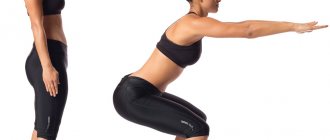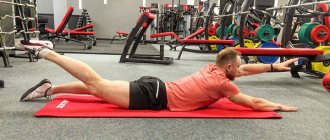Greetings, dear readers. In fact, the period of waiting for a baby should be filled with joy for every woman. And no changes in the body should upset you. And if a woman feels great, there are no threats and there is permission from the doctor who is observing her, then she simply needs fitness for pregnant women.
In fact, the old prejudices about pregnant women have long been a thing of the past. They are no longer treated like crystal vases. While everyone knows how beneficial exercise is for every expectant mother.
That is why in this article I will tell you about the benefits of fitness. I’ll also be sure to introduce you to specific exercises that need to be done in each individual trimester.
Benefits of exercise for pregnant women
- Thanks to intensive and proper breathing, the body is saturated with oxygen
- physical exercise maintains muscle tone in the lower back, creates a frame that will help bear a child
- maternal activity favors fetal development
- sport is recommended for those parents who have abnormal fetal positioning
- exercising during pregnancy will make pushing during contractions easier
- reduce stress levels and improve mood
Of course, you should remember that any sports activity should be moderate, and first of all you should consult with a gynecologist-obstetrician who will help you decide what intensity of exercise is right for you.
And if you do not have any complications, and the pregnancy proceeds without risks, you can easily choose a set of exercises just for yourself.
Fitness for pregnant women: where to start
During the first trimester, try to gradually develop the habit of exercising. The right amount of exercise will depend on how active you were before pregnancy. It is best to give preference to exercises with minimal impact on the body, such as walking, yoga, swimming and aqua aerobics.
Sometimes more vigorous exercise is often appropriate in the first trimester. For example, running, jogging and moderate weightlifting. Although there are many benefits to such exercises, be sure to consult your doctor before starting any exercise routine.
A woman who was active in exercise before becoming pregnant should consult with her doctor and personal trainer to develop a proper future exercise plan that takes into account her current situation and is safe during pregnancy.
What to pay attention to
The training process for women in an interesting position differs significantly in certain specifics. Even if you have been involved in sports all your life and are now in excellent condition, you should still know about the requirements and specifics of this physical activity.
First, let's first talk about how to provide yourself with the necessary comfort. Clothing must be spacious and breathable. The room is well ventilated, but without drafts.
Now about the contraindications: avoid jumping and active leg exercises. And, of course, you shouldn’t try to pump up your lower abs.
After eating, wait at least half an hour before you start exercising. However, do not attempt the exercises on an empty stomach.
If you suddenly feel that your temperature is rising or your blood pressure is jumping, or you simply feel unwell, then you should not continue doing the exercises, you should immediately consult your doctor.
Remember that changes in hormonal levels can weaken your joints. You shouldn’t put intense strain on yourself right away, especially in the first trimester.
There are a number of workouts that are considered the best exercises for pregnant women at home: yoga, stretching, Pilates.
Classes in the second
| Extending the body from a standing position | IP: take a vertical position; feet slightly apart from each other; back straight; the arms are in a free position along the body. As you exhale, you need to rise on your toes as high as possible without bending your legs. At the same time, raise your arms straight up to the sides. After pausing at the top point for 3-4 seconds, during which you need to stretch your spine upward as much as possible, slowly return to the starting position. |
| Crunches | IP: stand up straight; straighten your shoulders; place your hands along the body; Place your feet as close to each other as possible. As you exhale, you need to smoothly bend down, while gradually “twisting” each part of the body. For example, at the very beginning of the movement, the chin is pressed towards itself, then the head is lowered, stretching the muscles of the neck, then there is a deflection in the thoracic spine, and so on. Having reached the lowest point, the pregnant woman must simultaneously return to the original position with a deep breath. |
| Back arches | IP: position the body vertically; straighten your shoulders; put your hands on your belt; move your feet away from each other at a distance equal to shoulder width. As you inhale, bend your thoracic spine as much as possible, while leaning your body forward, as if trying to bring your shoulders together in front of you. After holding in this position for 2-3 seconds, simultaneously with exhalation, change position, performing a mirror bend back. In this case, the shoulders are turned back, the elbows seem to be touching. Without pausing at the obtained point, return to the starting position. When performing this exercise, it is extremely important to ensure that deflections are carried out only in the thoracic spine; the lower back and lower body remain motionless. |
| Pelvic rotation | IP: take a vertical position; place your feet shoulder-width apart; place your hands on your hips; the back is as straight as possible. Start rotating your pelvis, slowly drawing a circle in the air. During this exercise, it is important to avoid excessive bending and bending. After 5 rotations in one direction, change the direction of the rotating movement. |
Yoga
On the Internet you can find a lot of videos of exercises for pregnant women at home. Especially often pregnant women choose yoga.
The advantage of this type of training is that it helps both physically and psychologically.
The internal state of the expectant mother has a huge impact on the development of the fetus and the further calm of the baby.
That is why smooth and measured movements with deep breathing restore spiritual harmony, reduce stress levels, and relieve mild toxicosis.
Various asanas help maintain beautiful posture, strengthen the pelvic bones and promote smooth opening.
Fitness for pregnant women: how to avoid complications
To avoid complications, avoid:
- exercises with heavy loads;
- contact sports;
- sudden and sharp movements;
- exercises with a high risk of falling, such as gymnastics or aerial sports;
- jumping;
- high-intensity exercise, which increases your heart rate and breathing, making it difficult to talk;
- sports that cause excessive sweating;
- exercises that involve significant twisting of the body and torso, such as skiing;
- bending back;
- raise your legs above your head;
- exercises that put sudden pressure on the pelvis and torso, such as horse riding;
- exercise that increases the risk of overheating;
- Standing for too long can cause blood to pool in your legs.
Swimming
Many pregnant women do not want to resort to complex workouts, since there is already additional stress on the back and the body as a whole. But you don't feel the weight in the water, so swimming is a great option.
The muscles of the legs, back, and arms work steadily and without intense stress. During the procedures, it is necessary to monitor your condition, water temperature, and the absence of sudden movements.
Particular attention should be paid to exercises for pregnant women in the third trimester, because special training with an instructor will help in case of malpresentation of the fetus.
Sports For two: 10 YouTube workouts for pregnant women
Text: Olga Lukinskaya
The need for complete rest during pregnancy is one of the common misconceptions. Physical activity during this period is useful and recommended, unless, of course, your doctor prohibits it. There are not many restrictions: you need to avoid situations in which there is a risk of injury or a blow to the stomach, and remember that increased flexibility of the joints can lead to dislocation during sudden movements or jumps. It is important not to choke, but to maintain the intensity of the load. After the first trimester, it is not recommended to lift weights while lying on your back, since this may impair venous outflow. Taking into account these restrictions, you can choose any type of activity that you like and are accustomed to. We have prepared a selection of videos with a variety of workouts for pregnant women.
Bodyweight training for all muscle groups, suitable for any trimester of pregnancy. This is one of many videos by Amy, the author of the BodyFit by Amy channel, with different types of cardio and strength training for pregnant women; This particular workout is suitable for almost everyone. For those who like to keep the process under control, there is a countdown timer on the screen.
A dance cardio workout that is suitable even for those who have never danced, and includes exercises to develop lower back flexibility and leg muscle strength. The comments say that this is also a great workout if you are not pregnant, but are just starting to learn to dance (or just want to warm up and have fun). A special pleasure is Keira’s voice and intonation.
A calm, smooth workout that does not require additional equipment exclusively on the muscles of the buttocks. Leg swings while on all fours and squats supported on a chair improve balance. Only fourteen minutes, but you can combine these exercises with training for other muscle groups, quality stretching or, for example, meditation.
For those who work out: Nicole Monear, a professional fitness athlete, talks about the role of sports in her life and pregnancy. This is a thirteen minute overview of gym exercises for the legs, chest, shoulders, arms and back. Nicole shares how to modify weight-bearing exercises during pregnancy so that they are safe and beneficial for both mother and baby.
Charlie and Misha Zamora, an athletic couple, share how to keep up your gym workouts during pregnancy. Charlie mentions a common problem: the doctor does not seem to be against physical activity, but if he himself is far from sports, then, most likely, he will take the path of unnecessary restrictions in order to play it safe. This video is not so much a workout as an inspiring example, and its authors do a great job of explaining the dos and don'ts.
Amy again, this time showing light cardio with elements of kickboxing. These are swings and lunges, imitation of kicks and punches; the punching bag is present in the frame, apparently, only to create atmosphere. We recommend being careful with sudden movements in the hip joints, and also stocking up on a good sports bra and possibly elastic abdominal support.
Here's half an hour of yoga to develop strength and balance. Prenatal yoga is especially popular because it eliminates sudden movements or the possibility of shortness of breath, works the muscles well and, like any other activity, improves blood circulation. Christine McGee is a famous Hollywood Pilates and yoga instructor, who claims that with their help it is quite possible to “sculpt” a muscular body.
For aerobics lovers: a workout that makes you want to wear colored leg warmers and a leotard, like in the 80s. True, in the comments they complain about the excessive positivity of the instructor, who praises or encourages the audience every few seconds. Don't forget a water bottle and non-slip shoes; Even if you are working out at home, it is better to wear sneakers for safety reasons.
A very beautiful video with training in water. In the pool you can do exercises for the whole body, separately for the top or bottom, stretching and, of course, just swim. Like yoga, swimming is characterized by minimal trauma and the absence of excessive stress on the respiratory system. And a swimming pool is a great option for hot summers, when it becomes difficult to even walk.
This short video is suitable for those who have been training on their own for a long time. This is an example of a third trimester program that includes strength training, cardio, and yoga. Excellent work on the buttocks, legs, back and triceps, followed by aerobics with elements of kickboxing (or other cardio exercise), and then yoga and stretching. Just two minutes that you can use for inspiration to update your training routine or add new exercises.
cover: Drobot Dean – stock.adobe.com
Stretching
Stretching is also one of the weight loss exercises for pregnant women at home.
Exercising helps maintain body flexibility, increase muscle elasticity, and reduce the burden of weight gain.
Unlike other training sets that are recommended to be emphasized in the first and second trimester, stretching will help more in the final stage of the “standby mode”.
Leg stretching exercises prevent perineal tears during childbirth.
Hiking during pregnancy
A very useful vacation, as well as a special sport that forces different muscle groups to work simultaneously. At the same time, too long walks in this position are undesirable. The time spent walking should be approximately 20–40 minutes. You should also not neglect such important nuances as a hat and a bottle of water when walking in the summer. During the third trimester of pregnancy, special products such as a support bra and prenatal bandage may be used. It is also important to take care of your shoes; they should be as comfortable as possible.
We must not forget about this rule: after a walk, you need to sit down or lie down for a while with your legs raised to prevent blood from stagnating in the veins.
It is worth noting that moderate and regular light physical activity affects the body of a pregnant woman and her unborn baby only in the most positive way. The body becomes stronger and more resilient, which will make childbirth easier. But it is important to always be careful, avoid sudden movements and overloads, and constantly monitor your general well-being.
Kegel exercises
This set of simple workouts is specially designed for pregnant women, as it helps strengthen the muscles of the vagina and pelvic floor.
Moreover, it is recommended to perform this complex throughout pregnancy.
In this way, the woman will be able to prevent the prolapse of internal organs and maintain their normal functioning.
Contraindications to gymnastics
In some cases, exercise for pregnant women is harmful to health and therefore may be strictly prohibited. Contraindications to gymnastics include:
- pathologies of pregnancy development - placenta previa or abruption, gestosis, polyhydramnios or oligohydramnios, threat of miscarriage (including uterine hypertonicity, blood discharge from the genital tract);
- chronic and colds (ARVI, gastritis, pyelonephritis, hypertension or hypotension, diabetes, etc.);
- pain in the lower abdomen;
- severe swelling of the limbs.
After making sure that there are no contraindications and after the permission of the attending physician, the woman can play sports. But at the same time, the expectant mother needs to carefully monitor her well-being during and after training - if pain, dizziness, changes in blood pressure and heart rate, as well as other alarming symptoms occur, exercise should be stopped.
First trimester
The most important thing to remember when creating an at-home exercise program for pregnant women in the first trimester is caution.
At this time, the body is experiencing global changes, a hormonal explosion, which makes the joints weakened and sensitive to any load.
In addition, at this time, all the child’s organs are being formed.
Recommended activities include: walking, breathing exercises, swimming.
Particular attention should be paid to oxygen saturation. Therefore, even walking in the fresh air is ideal.
Video with a special set of exercises
Gymnastics for pregnant women in the 3rd trimester is presented in the video. Famous TV presenter Masha Efrosinina shows what exercises helped her stay slim during such an exciting period of expecting a baby.
Have you done exercises for pregnant women, and at what trimester did you start exercising? Were there any contraindications to physical activity? What set of exercises for pregnant women were performed in the 3rd trimester? Share your experience with our readers in the comments.
Second trimester
By the fourth month, the woman’s condition has already stabilized, the placenta is formed, so sports no longer causes such harm.
In addition, weight gain in the abdomen puts additional stress on the back and legs.
Therefore, a course of exercises for pregnant women at home in the second trimester should include training the back muscles and strengthening the support corset.
The set of breathing exercises is also being transformed: you can introduce training in jerky and diaphragmatic breathing, as well as breathing on all fours “during contractions.” These exercises will help maintain the tone of your abdominal muscles.
What physical exercises should you not do during the 3rd trimester?
Prohibited sports activities:
- all kinds of crunches that involve the abdominal muscles;
- high intensity exercise;
- shoulder press;
- exercises lying on your back;
- contact types of load;
- hot yoga;
- deep squats or deadlifts (especially sumo);
- weightlifting and athletics.
Of course, this list can be expanded and supplemented depending on the individual characteristics of the course of pregnancy.
Third trimester
At this time, there is a dual attitude towards training. On the one hand, you have already gained enough weight that physical activity is difficult for you; shortness of breath and pain in the lumbar spine may appear.
However, this is not a reason to give up training. Remember that at this time the fetus is also actively gaining weight.
Sports will help you provide your unborn child with additional activity and prepare the pelvic bones for childbirth.
To unload your back and pelvis, you can actively use a fitball.
Pilates will also help you after childbirth - to quickly get back into shape and normalize the functioning of your internal organs.
If you prefer aerobics, in the final stages, pay special attention to “sitting” poses or exercises from the “on all fours” position.
The main thing is to monitor your own condition, perform exercises at a slow pace, and avoid overload and pain.
And, of course, any form of exercise is strictly prohibited in case of threat of premature labor or placenta previa.
When should pregnant women not exercise?
Many women refuse exercise during pregnancy, considering it dangerous. This may be justified if the pregnant woman is not feeling well. Before you start doing exercises, it is better to consult a specialist .
Physical activity is undesirable in the following cases:
- With severe toxicosis, accompanied by vomiting more than twice a day;
- Toxicosis (preeclampsia) in late pregnancy;
- If a previous pregnancy ended in miscarriage;
- With uterine hypertonicity;
- With a low placenta;
- If there is a threat of miscarriage and bleeding;
- For pain in the abdomen;
- At elevated temperatures, ARVI, diabetes and gastritis.
If the expectant mother feels good and there are no contraindications, you can safely start doing exercises. However, it happens that a few days after the start of classes, a pregnant woman feels discomfort. Then you should refrain from physical activity for a couple of days to listen to your body. Muscles may react this way to stress, especially if you did not exercise before pregnancy. Then it is better to rest, recover, and then return to physical activity again. During pregnancy, you should not put too much stress on yourself, since you are responsible not only for your health, but also for the health of the unborn baby.











